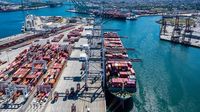The global trade landscape is undergoing significant shifts, with the US-China trade conflict at the heart of these changes. Since the initial imposition of sweeping US tariffs on Chinese imports in 2018 and 2019, followed by retaliatory measures from China, the repercussions have echoed worldwide, reshaping supply chains and trade flows in unprecedented ways.
Recent research has illuminated the complex effects of these tariffs. Studies by Fajgelbaum and Khandelwal (2022) have assessed the economic costs to both the US and China, while Utar et al. (2023) and Alfaro and Chor (2023) have highlighted the consequential 'Great Reallocation' of global supply chains towards nations like Mexico. New findings by Chen, Novy, and Solórzano (2025) provide fresh insights into how Mexico, in particular, has benefited from trade diversion, with notable positive impacts on Mexican workers.
Trade diversion occurs when tariffs imposed by a large economy, such as the US, on a major partner like China, incentivize importers to source goods from alternative suppliers. In this case, Mexico emerged as a key beneficiary. As US imports from China declined following the 2018/19 tariffs, imports from Mexico rose, effectively filling the void left by Chinese goods. This shift was facilitated by Mexico's competitive labor costs, geographical proximity to the US, low transportation expenses, and the advantages conferred by trade agreements such as NAFTA and its successor, the USMCA.
Using highly detailed Mexican firm-level export data, researchers estimated that a 25 percentage point increase in US tariffs on Chinese goods corresponded with a 4.2% increase in Mexican exports to the US. This growth was driven by both increased export volumes and a broader range of products being shipped. But the story doesn't end with trade figures; the labor market effects in Mexico are equally telling.
By linking export data with matched employer-employee records, the study found that a 1% rise in Mexican firm-level exports to the US, spurred by tariffs on China, led to an average wage increase of 0.103%. Importantly, these wage gains disproportionately benefited female, unskilled, younger, and non-permanently insured workers—groups traditionally disadvantaged in the labor market. Women, for instance, saw wage increases roughly double those of men, indicating that trade diversion contributed to reducing wage inequality within firms.
However, the employment effects painted a more nuanced picture. While firms increased employment by 0.146% in response to export growth, the mean wages at these firms decreased by 0.197%. This decline was attributed to a composition effect: firms hired more low-wage workers to meet rising demand, particularly in technology and skill-intensive manufacturing sectors such as chemicals, rubber, plastics, machinery, and automotive industries.
These findings underscore the tangible third-country spillovers of large-economy trade policies. The US-China tariffs not only disrupted direct bilateral trade but also created opportunities and challenges for other nations. Mexico's experience reveals that while protectionism often carries costs, it can also yield benefits for bystander countries, especially for vulnerable worker groups.
Looking ahead, the most recent round of US tariffs initiated in 2025 targets a broader array of countries and industries, introducing greater uncertainty. The complexity of these measures suggests that future trade diversion effects on third countries’ trade and employment will be more intricate and multifaceted.
Meanwhile, on the agricultural front, the United States Department of Agriculture (USDA) reported a generally positive week for key export commodities ending June 12, 2025. Corn led the way with improved sales, buoyed by strong demand from Japan and Mexico. Soybean sales also rose, particularly to Germany and Mexico, with new crop sales for both commodities exceeding the previous week’s figures. Pork exports climbed, with Mexico purchasing more than half of the total, and wheat sales increased compared to the prior week.
Conversely, sales of beef, soybean products, sorghum, and cotton declined, while rice sales hit a marketing year low. The USDA's next supply and demand projections are scheduled for release on July 11, 2025.
Examining the details, wheat sales totaled 427,200 tons (15.7 million bushels), with Taiwan and the Philippines as major buyers. Corn sales reached 903,800 tons (35.6 million bushels), a 14% increase from the previous week, though slightly below the four-week average. Japan and Mexico were significant purchasers, though unknown destinations canceled a substantial volume. Corn exports for the 2024/25 marketing year stand at 2.631 billion bushels, up from 2.08 billion the previous year.
Sorghum sales, entirely to Mexico, were 50,800 tons (2 million bushels), down 44% from the prior week but 64% above the four-week average. Rice sales dropped sharply to 9,800 tons, with Nicaragua and Japan as primary buyers. Soybean sales rose notably to 539,500 tons (19.8 million bushels), with Germany and Mexico leading purchases. Soybean meal and oil experienced declines in sales, while upland cotton sales increased by 38% from the previous week, primarily to Vietnam and Turkey.
Beef net sales decreased by 24% to 11,700 tons, with Japan, South Korea, and Mexico among the main buyers. Pork sales surged to 28,200 tons, with Mexico accounting for more than half. Shipments for both beef and pork showed mixed trends, reflecting ongoing fluctuations in global demand.
At the Port of Los Angeles, one of the nation’s busiest trade gateways, officials face ongoing challenges amid the trade tensions. In a June 13, 2025 media briefing, Port Executive Director Gene Seroka reported that container processing in May 2025 fell 5% compared to the previous year, with imports down 9% and exports down 5%. This marks six consecutive months of declining exports, adversely affecting American farmers.
The port handled 195.2 million metric tons in 2024, including over 633,000 metric tons of fruits and vegetables. Seroka planned to attend the Agriculture Transportation Coalition Conference in Tacoma, Washington, to strategize on boosting US exports. Ernie Tedeschi, director of economics at Yale's Budget Lab, noted that the China trade tariff has raised the average effective tariff rate in the US by 12%, potentially increasing prices by 1.5% and reducing the average family's purchasing power by $2,500 annually.
Looking ahead, two critical dates loom: August 11, 2025, marking the end of the 90-day pause in US-China trade negotiations, and July 8, 2025, for other countries excluding Canada and Mexico. While extensions are possible, these timelines add to the complexity faced by stakeholders. There is broad consensus on the need for long-term, comprehensive trade agreements to stabilize the environment.
In Wyoming, the soda ash industry, the state's largest export sector valued at $1.5 billion and accounting for 65% of all exports, also feels the strain of trade tensions. Jon Conrad, head of governmental affairs for TaTa Chemicals, oversees a refining plant where trona mineral is processed into soda ash, a vital ingredient in glass, batteries, detergents, and more.
Conrad described the current situation as a "terrible business strategy" due to uncertainty caused by tariffs and reciprocal trade policies. While US tariffs might boost domestic soda ash use, retaliatory tariffs by importing countries raise prices abroad, threatening demand. Wyoming competes against China, which offers cheaper synthetic soda ash without tariffs, posing a significant challenge.
TaTa Chemicals has the capacity to increase production, potentially boosting jobs and revenues, but global political uncertainties have led to a cautious approach. As freshly refined soda ash is loaded into railcars—each carrying about 100 tons—it embarks on its journey to markets worldwide, navigating a complex and evolving geopolitical landscape.
These intertwined stories from trade policy to commodity exports and regional industries underscore the far-reaching and multifaceted impacts of global trade dynamics. As tariffs, negotiations, and market shifts continue to unfold, stakeholders across sectors and borders watch closely, adapting strategies to seize opportunities and mitigate risks in an uncertain world.





